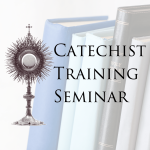In Catholic circles, perhaps no other sacrament raises such a wide variety of interpretations and explanations as the sacrament of confirmation. Sometimes, well-meaning Catholics will say they can’t wait for their child to receive confirmation because then they will finally be “choosing their own faith,” or they will be “making it their own.” Other times, you will hear Catholics describe confirmation as a sort of graduation, as a sacrament that somehow relates to our maturity; being confirmed could be akin, in this frame of mind, to a Jewish bar mitzvah.
However, these sorts of rationales for confirmation have more to do with contemporary experience and the age at which the sacrament is received than with the theology of confirmation itself. Since many Catholic dioceses (all but 13 in the United States) admit people to confirmation somewhere in the middle school to high school range, it has come to be seen as an adolescent rite of passage, as a sort of ceremony tied with maturity or entrance into adulthood.
Yet, as we explore the history of the sacrament and its theology, what we see is something that looks a bit different. In the earliest period of the Church in the West, baptisms and confirmations were performed by bishops in a single celebration. It was clearly understood there were two sacraments involved, but the ritual involved both sacraments. Due to the rapid spread of the faith and the desire for baptism, priests and deacons eventually were given permission to baptize, and bishops would travel around for confirmation. In the East, baptism, confirmation, and Eucharist were all celebrated together, and priests were ordinarily given permission to confirm. However, to maintain a link to the bishops, priests could only use chrism oil that had been consecrated by a bishop. The historical link to baptism is maintained even today, where infant baptism is the norm and a later reception of confirmation is the standard. During infant baptisms, the child is anointed with chrism oil, the same oil which will be used for their confirmation later.
The reason these details are helpful is that we can see, both from the early practice of the Church and even in the current practice (especially in the East), confirmation is sometimes given to children. If the sacrament can be given to children, then how can we understand its rationale? It can’t be the case that confirmation is about maturity or choosing the faith if we can offer the sacrament to an infant. So then what is its purpose?
The Catechism of the Catholic Church highlights the effects of confirmation in paragraphs 1303-1305. In paragraph 1303, we read:
“Confirmation brings an increase and deepening of baptismal grace:
•It roots us more deeply in the divine filiation
which makes us cry, “Abba! Father!”;
•It unites us more firmly to Christ;
•It increases the gifts of the Holy Spirit in us;
•It renders our bond with the Church more perfect;
•It gives us a special strength of the Holy Spirit to spread and defend the faith by word and action as true witnesses of Christ, to confess the name of Christ boldly, and never to be ashamed of the Cross.”
Note that, in large part, the effects of confirmation are ways in which confirmation deepens, completes, or “confirms” our baptism. Baptism, of course, makes us a son or daughter of God. But confirmation “roots us more deeply” and helps us to truly see God as our Father, and to call him, “Abba! Father!” Baptism unites us with Christ, but confirmation unites us more firmly. We receive the Holy Spirit at baptism, but confirmation increases the gifts of the Holy Spirit in us. In baptism, we become a member of the Church, but confirmation renders that bond more perfect.
This is not to imply that baptism and confirmation are the same, but rather that these two sacraments both shed light on one another. By virtue of the anointing with chrism at baptism, we are pointed toward our confirmation, and in confirmation, we are reminded of our baptism. We are, though, not just reminded of our baptism, but in a way enter more deeply into that identity we originally received at the baptismal font. We are given more grace to live out our baptismal calling through the gift of
confirmation.
The Catechism of the Council of Trent makes this remark regarding the difference between baptism and confirmation:
“For those who have been made Christians by baptism still have in some sort the tenderness and softness, as it were, of newborn infants, and afterwards become, by means of the Sacrament of chrism, stronger to resist all the assaults of the world, the flesh and the devil …” (p. 221)
Later on, the Catechism of the Council of Trent notes that the faithful receive, in their own confirmation, the same spirit that the apostles received at Pentecost. So, we can look to the experience of Pentecost to understand the purpose of confirmation. In this light, we see one of the most clear distinctions between baptism and confirmation: confirmation helps us to be witnesses, to stand up for the faith, and even to suffer.
Pope Francis and Pope St. John Paul II both speak of the importance of all Catholics recognizing their baptismal dignity, and the link between baptism and our call to missionary discipleship. This foundation is laid in baptism, but it is through the graces of confirmation that we are particularly strengthened for that public witness to the Gospel.
As we embark on the year of confirmation in the Diocese of Tyler, let us all embrace the link between our baptism and confirmation, and take seriously the call we have all received to be a witness to Christ in our daily lives.



